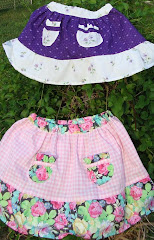 The photo shows some of what came in this week. Plus DH dug a couple rows of potatoes yesterday that he laid out to cure before we store them in a cool cellar. All the garden and kitchen work means meals were cobbled together from the fresh produce and make-ahead dishes from the fridge or freezer. Yesterday's supper was no exception.
The photo shows some of what came in this week. Plus DH dug a couple rows of potatoes yesterday that he laid out to cure before we store them in a cool cellar. All the garden and kitchen work means meals were cobbled together from the fresh produce and make-ahead dishes from the fridge or freezer. Yesterday's supper was no exception. It was a filling vegetarian feast that included Marinated Tomato and Green Pepper Salad, one of our favorite make-ahead salads, yellow eye beans and lacy corn meal cakes with slices of a Sugar Baby watermelon for dessert. The vegetables and watermelon came from the garden, the cornmeal I ground fresh from local dried corn, the egg in the griddle cakes came from the backyard girls and I thinned whole-milk yogurt made from rich local milk for the cakes, too. Tho the recipe doesn't require it, I used fresh ground whole wheat (local) for the indicated flour amount. I think the whole grain adds an extra boost to the flavor of the griddle cakes tho they're also great made with regular all-purpose flour.
The yellow eye beans aren't very common apparently but I came across them several years ago at a little produce market in Pulaski that featured local farm products. We ate most of what I brought home but saved back enough seeds to plant our own the next year. The texture is creamier than a pinto, if that makes sense, and the taste reminds me a little of a navy bean. We all like dried beans so it was nice to find a new-to-us variety to add to the mix.
The cornmeal griddle cakes are a great way to have a hot bread with a meal without heating up the oven and they're fast to fix, too. My mom likes to make the batter thin (add more liquid than recipe indicates) and make the cakes crisp and lacy. If you want, you can spread butter on them but that's gilding the lily as far as I'm concerned but a spoonful of sorghum is a good choice especially if you're eating one at the end of the meal.
Cornmeal Griddle Cakes
2 cups buttermilk or about 1-1/4 cup yogurt thinned with 3/4 cup water
1 egg, beaten
1 teaspoon salt
2 tablespoons vegetable oil
1 teaspoon baking soda
1-1/2 cups cornmeal
1/2 cup all-purpose or whole wheat flour
Combine dry ingredients in a mixing bowl. Make a well in the middle and pour in buttermilk and add eggs. Beat till smooth and then add oil, stirring to combine. Cook on a hot griddle like a pancake or fry in a skillet to which a teaspoon of oil has been added. Yield: 8-10 cakes.














